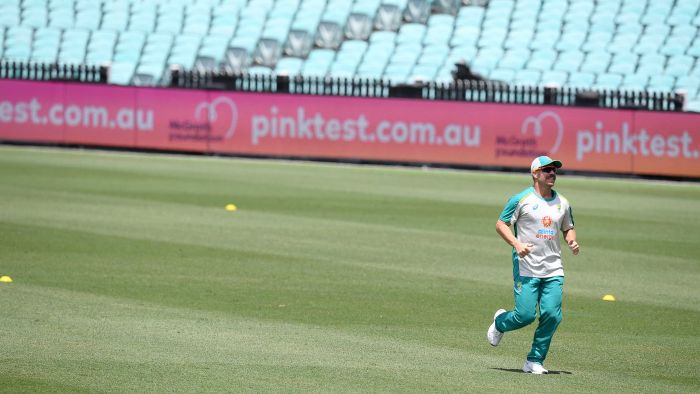After a first week of January that felt a lot longer, the Sydney Test will end a fraught lead-up when it finally gets underway.
Not that it means that conducting the match will be any less fraught. Such are the unknowns of staging major events in the middle of viral outbreaks.
It was December 29 when Cricket Australia (CA) insisted that the Test match should go ahead in a city where COVID-19 had breached containment lines, rather than using one of several cities where it had not.
Mercifully, the daily case numbers in New South Wales have stayed low, but that was no surer than a gamble when the decision was made.
Cases continue to be found and traced, as has their spread to Melbourne where the preceding MCG Test is now under investigation as a transmission site.
Meanwhile, unfounded optimism from CA and the New South Wales government has predictably had to be reined in.
They started with projections of crowds at 50 percent capacity and hopefully more, and are now down to 25 percent capacity and probably less.
In a matter of days, medical masks went from spectator’s choice to recommended to mandatory, the progression of a chronic government reluctance to be decisive.
Then there was the matter of staging a spectacle that encourages people to visit Sydney when health advice was that no one should visit Sydney, and that anyone who did would need a fortnight’s quarantine on entering another state.
Deputy premier John Barilaro’s line to country constituents on January 4 was typically half-hearted: “My advice to people would be — think about it, reconsider, maybe this year isn’t the year to come to Sydney to watch the Test and that’s what we’ll be doing.”
“If you live in Auburn, Berala, Lidcombe North, Regents Park or Rookwood, we would love you at the Test in a non-COVID year, but we can’t [this time],” he said. On January 6 he added more suburbs.




The credibility of everything above is summed up by the ban on Rookwood, a place with zero residents given it’s entirely a massive cemetery that boasts the dubious distinction of being “the largest necropolis in the Southern Hemisphere”. Take that, Chile.
If you incorporate the ideas of the departing US President, getting dead people involved can be a way to pad out numbers. Rookwood residents could boost the SCG attendance without raising its risk of transmission.
The other option is that if the virus does get to the cricket, the traffic flow might be from the SCG to Rookwood rather than the other way around.
For Hazzard, the episode was a bit too close to Rudy Giuliani opposite a crematorium. But that’s the world that we and our cricket team live in. At least CA can be grateful that months ago India requested a later start date — imagine the chaos had the first day been January 3.
As to why it was vital to stage this match in Sydney, we’ve kept hearing that CA owed Cricket New South Wales (CNSW) and the SCG for having staged some white-ball games last year that had to be moved from Queensland.
A better view is that the SCG got four bonus games against India with decent crowds, and so has already had its share.




But entitlement to a Test match is about power and privilege. Try imagining the same determination to keep a match scheduled in Hobart in these circumstances.
CNSW is the most powerful state association, having effectively sacked CA’s previous chair and chief executive.
Then look at the SCG Trust board, the Venues NSW board, the CA board, and the ranks of Liberal Party politicians and advisors. It’s easy to miss where one stops and the next begins.
At the centre of this swirl will be the teams taking the field. Australia is under pressure to stay in the hunt for the Border-Gavaskar trophy, having failed to top 200 with the bat in the series thus far.
This brings about the unusual situation of picking a player who isn’t fully fit, though David Warner says his groin strain is a matter of residual tendon pain rather than a weakness that risks re-injury.
Then there’s the question of whether to double-change the openers by bringing in Will Pucovski to debut after his many concussions. That would send Matthew Wade back down the order and push out Travis Head.
India also welcomes back a destructive opener from injury in Rohit Sharma, an easy swap given Mayank Agarwal hasn’t coped with Australia’s new-ball bowling.




Among India’s quicks, Mohammed Siraj impressed on debut in Melbourne and keeps his spot, while Navdeep Saini debuts to replace the injured Umesh Yadav. Saini was picked for the tour as a bowler who naturally maintains pace and hits a hard length, in a way the Indian camp thinks will suit Australian conditions.
But experience is scant. It’s easy to forget that Jasprit Bumrah will lead these two having played only 16 Tests himself. This is what Australia’s batting has to target, before the tried and tested spin duo of Ravichandran Ashwin and Ravindra Jadeja can take control.
The home team has a fight on its hands. Even the small part of this match that happens within the boundary line will be complicated.







